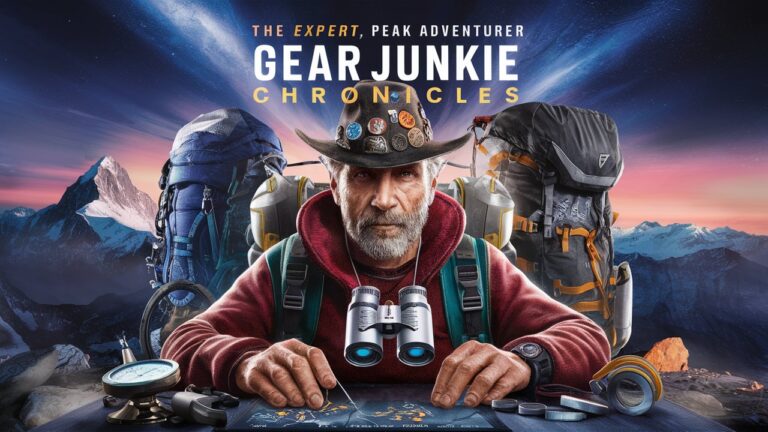The Gear Junkie Manifesto: More Than Just Stuff
To be a Gear Junkie is to embrace a philosophy where equipment becomes an extension of human capability. It transcends mere consumerism, evolving into a relentless pursuit of innovation that empowers outdoor experiences. Founded in 2002 by Stephen Regenold—who famously tested Vibram FiveFingers shoes with 100 miles of running before reviewing them—the ethos demands “testing to death” to uncover a product’s true soul 1. This creed transforms gear evaluation into adventure narratives: reviewers don’t just list specs; they frame stories around blistered trails, Alaskan downpours, or mountain face climbs. As Regenold insists, readers crave tales of how gear performs when nature turns ruthless—not sterile technical jargon 1. For GearJunkie’s 32-strong team (now an AllGear Digital subsidiary), this mission blends journalism with alpinist passion 14.
The Anatomy of Excellence: GearJunkie Review Standards
Rigor as Religion
Every product undergoes brutal real-world interrogation. Sleeping bags face sub-zero nights; backpacks endure 1,000-mile thru-hikes. This isn’t casual testing—it’s “using the most knowledgeable experts in the field” to simulate life-or-death scenarios 3. Long-term durability matters as much as initial performance. The BioLite Luci Lantern, for instance, earned reverence for surviving a decade of campsite abuse 2.
Ethical Non-Negotiables
“No payment for favorable reviews. Period.” This mantra anchors GearJunkie’s credibility. While sponsored content exists (<10% of total material), it’s conspicuously labeled. Products arrive unsolicited or are purchased anonymously. Most are “used hard” then returned or retired to long-term testing labs 3.
The Rating Hierarchy
A proprietary 10-point scale separates icons from imposters:
- 9.0–10 (Elite): Revolutionary designs like Saucony’s IncrediRUN foam in the Endorphin Elite 2 ($275), which redefined energy return 4.
- 6.0–8.9 (Recommended): Workhorses like UCO’s Whidbey knife—affordable, reliable, but unremarkable 13.
- <6.0 (Caution/Poor): Flawed gear that fails under pressure, like leaky “waterproof” shells 3.
Emerging Gear: Innovation at the Edge
2025’s Trailblazers
- TRAK 2.0 Kayak: A $3,650 folding craft with hydraulic rocker adjustment and hard chine hull for ocean expeditions. Sets up in 15 minutes yet handles like a hard-shell 4.
- ROAM Smart Tracker: Carbon-negative device made from recycled materials. Its elastic strap secures to bikes/kayaks, offering landfill-proof upgrades via exchange programs 4.
- Speedland x Ben Gibbard Collab: The Death Cab for Cutie frontman’s ultrarunning expertise birthed a tech-forward trail shoe after his Western States finish 2.
Sustainability’s Rise
GROUNDTRUTH’s UNDA dry bags—crafted from ocean plastic—and Canada Goose’s $2,795 Sea Mantra parka (6 years in development) prove high-performance needn’t sacrifice ethics. Bluesign certification and carbon-neutral shipping are now baseline demands 4.
The Art of the Gear Review: A Masterclass
Beyond Specifications
Great reviews weaponize experience. When Nick LeFort dissected the Leatherman Rebar, he emphasized “years of excellence at a nice price”—contextualizing specs within decades of brand heritage 13. Sam Schild’s Free Fly Bamboo Hoodie review declared, “I wore this every day for 2 months,” transforming fabric stats into sweat-and-dirt testimony 10.
Structural Commandments
- Narrative Hook: Drop readers onto that storm-swept ridge.
- Brutal Honesty: “Be cruel if needed” when gear fails 1.
- Critical Details: MSRP, availability, weight, warranty.
- Visual Proof: High-res shots showing mud-caked gear in action 1.
- Audience Alignment: A $38,999 Polaris Slingshot 10 three-wheeler targets motorsport junkies; Prevelo’s $599 kid’s bike appeals to parents 4.
Gear as Craftsmanship: When Tools Become Art
Collaborations now fuse function with cultural resonance. Timberland’s GORE-TEX “hairy suede” boots with Tokyo’s nonnative ($220) married streetwear aesthetics to waterproof engineering 4. Similarly, K-Swiss x McLaren’s “Papaya” sneakers ($120) translated Formula 1 aerodynamics into running shoes—proving gear can embody subcultures 4. Cimoro’s Dyneema backpacks epitomize this, merging Savile Row tailoring with ultralight tech for “custom-fitted performance” 8.
Confessions of a Gear Addict: Psychology of the Obsession
The Scale of Addiction
Are you the hobbyist with three headlamps? Or the “lost soul” with eleven boot pairs and “a room dedicated to gear storage”? Philosopher Mike Hinsley captured this tension: “Sometimes I wonder if I’m more of a shopper than a hiker” 15. GearJunkie acknowledges this spectrum—from spreadsheet-toting weight weighers to collectors valuing gear over cars.
Healthy vs. Unhealthy
Passion becomes pathology when:
- Debt funds new purchases.
- Gear rooms expand while trail miles vanish.
- Spreadsheets replace summit bids 15.
Yet curated obsession drives progress. Testing 15 rain jackets to crown “The Best” (as GearJunkie’s teams do) serves community needs 2.
Conclusion: The Junkie’s Journey
GearJunkie’s legacy lies in transforming equipment scrutiny into a celebration of human potential. It’s not about accumulating gadgets—it’s about curating tools that dissolve barriers between ambition and achievement. As emerging tech like solar-powered computers and “super aluminum” knives enters the fray 413, the junkie’s quest persists: finding brilliance that lets the wilderness, not the gear, dominate our memories.
Frequently Asked Questions
Q: How does GearJunkie ensure review independence?
A: Absolute separation of church and state: Editorial never accepts payment for reviews. Most gear is purchased or returned post-testing. Sponsored content is clearly marked and capped below 10% of total output 3.
Q: What defines a ‘GearJunkie must-read’ review?
A: Three pillars: 1) Extreme testing (e.g., 100+ miles for shoes); 2) Narrative storytelling placing gear in life-threatening scenarios; 3) Radical transparency—pricing, flaws, and failure contexts 13.
Q: Are collaborations like Timberland x nonnative just marketing?
A: Not when executed authentically. These fusions inject fresh perspectives—Tokyo streetwear into classic boots—while maintaining core performance (GORE-TEX membranes, etc.) 4.
Q: How can I avoid unhealthy gear obsession?
A: Audit using two questions: 1) Does this enable adventures or replace them? 2) Would I sell my car to fund this? If gear rooms eclipse trail time, redirect energy toward muddy boots over mouse clicks 15.
Q: What emerging gear trends dominate 2025?
A: Sustainability (ocean-plastic dry bags), modularity (Prevelo’s balance-to-pedal kid bikes), and “cradle-to-cradle” lifecycle design (ROAM’s landfill-proof trackers) 4.
